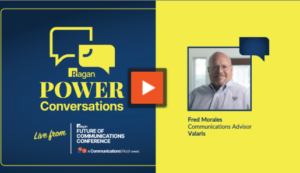‘Speak Now’: 5 internal comms lessons from Taylor Swift
Listen closely and you’ll find the pop queen’s lyrics are full of employee comms wisdom.

Feel like you’re stuck in a rut with your internal comms strategy? Maybe like you need to shake it off? Or perhaps you’re bored with the day-to-day of your position, feeling like you know your work all too well.
Here are five lessons internal communicators can learn from the queen of pop herself, Taylor Swift.
Read on for some tips and tricks you wouldn’t have thought of in your wildest dreams, pulled straight from five of Swift’s most iconic tracks.
1. You Belong With Me
Have you ever tried to convince your employees to stay with your company through employee experience messaging?
Swift is making a similar case in “You Belong With Me” as she tries to convince a good friend that his girlfriend just isn’t right for him, and that he’d be better off with her.
“If you could see that I’m the one who understands you / Been here all along, so why can’t you see? / You belong with me, you belong with me,” she sings.
When hoping to retain employees, it’s often necessary to make sure that workers know all the benefits they’re entitled to — even ones that may seem obvious. Though your company’s incredible work from home stipend or mental health resources might have been shared with employees during onboarding, it’s worth reminding them that these benefits are right at their fingertips. Try spotlighting your benefits some with monthly static posts on your company’s intranet or making benefits-focused short-form videos to send to workers via email.
It’s also possible to boost your employer branding reputation by committing to positively recognizing your employees’ accomplishments — both professional and personal. Dedicate some time to carving out a space for kudos on your intranet and watch as your employees become more engaged and motivated. Don’t forget that accomplishments can be celebrated publicly, too — work with your external comms team to brag about your employees on brand accounts, with workers’ permission, of course.
2. Back To December
As one of Swift’s most heart-wrenching songs, it’s easy to characterize this ballad as being solely about regret and romantic regression.
But hidden in the song are several powerful examples of how you can use positive change to move forward after a crisis or adverse event.
“You gave me roses and I left them there to die,” Swift sings woefully.
However, she follows it up with, “But this is me swallowing my pride / standing in front of you, saying, ‘I’m sorry for that night.’”
“‘Back To December’ is a song that addresses a first for me, in that I’ve never apologized to someone in a song before,” Swift said in an interview with Comcast. “This is about a person who was incredible to me- just perfect in a relationship, and I was really careless with him.”
Her words capture a common strategy deployed in effective crisis communication — acknowledging a past mistake and putting aside professional pride to explain why things happened the way they did. The best apologies take responsibility for the offending action or words, with the apologizing person striving to put their words ahead of themselves. Swift’s song also gets at another aspect of a good apology — focusing less on what you did wrong and more on what you’ll do to right the situation and improve in the future.
3. “How You Get The Girl”
This song is a step-by-step guide to getting someone back after a breakup. Swift lays it all out: apologize, be honest and support your feelings with examples.
It’s also good inspiration for comms pros who are looking for ways to talk to their C-suites about difficult or sensitive matters.
“Broke your heart, I’ll put it back together / I want you forever and ever (I would wait forever and ever) / And that’s how it works / That’s how you get the girl, girl (This is how it works)” Swift writes.
Communicators would do well to take a step-by-step approach to communicating with CEOs and other execs:
- Decide on your goals
- Gather data to support those goals
- Analyze and parse the data into a concise, understandable report
- Present to your C-suite confidently
4. The Last Great American Dynasty
Sometimes, taking calculated risks is the only way to emphasize the boldest elements of your company’s values and mission.
In internal comms, this can mean upending messaging norms and trying new things that your C-suite or colleagues might find outrageous.
“Absolutely outrageous” is how many have described Rebekah Harkness, an American composer and socialite who is the subject of Swift’s song, “The Last Great American Dynasty.” Harkness was known as a flamboyant, mischievous woman who was ahead of her time.
Swift writes of Harkness: “Who knows, if she never showed up, what could’ve been / There goes the most shameless woman this town has ever seen / She had a marvelous time ruining everything.”
There’s an oft-quoted saying, mostly attributed to Aristotle, which posits that “there is no great genius without a mixture of madness.”
The same logic applies when messaging employees about risky topics that may divide them or not be met with consensus. This can be better understood by conducting pulse surveys that encourage employees to be brutally honest about their experiences and directly informs changing company policies and purpose commitments.
5. “Dancing With Our Hands Tied”
“Dancing With Our Hands Tied” leads listeners through a winding journey of love that is ultimately doomed. It’s not about the end of the relationship, but about what the couple does in the days leading up to the end.
“People started talking, putting us through our paces / I knew there was no one in the world who could take it / I had a bad feeling / But we were dancing / Dancing our hands tied,” Swift writes.
This perfectly explains how employees feel during times of company change and operational upheaval — uncertain times can foster fear in workers who are unsure about whether they might lose their jobs or have their work irreversibly impacted.
In times like these, communicators should be at the forefront of employees’ daily lives, taking questions about what’s going on and doing their best to answer them. You can assuage fears by keeping everyone in the loop and engaging the most affected employees first to reduce the feeling of dancing with our hands tied. Consider setting weekly or bi-weekly town halls, hosted by a comms team member and a C-suite member.
So next time you’re feeling stuck about your messaging strategy, try turning to your favorite artist; there could be some real gems of advice hidden among the beats and melodies.
We’ll leave you with one final piece of advice: When you’ve got a great idea, don’t sit by — speak now!







